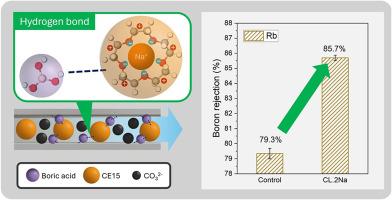15-冠-5功能化层状双氢氧化物使薄膜纳米复合膜增强反渗透脱盐和除硼
IF 9
1区 工程技术
Q1 ENGINEERING, CHEMICAL
引用次数: 0
摘要
不断升级的全球水危机加剧了对先进和强大的海水淡化技术的需求。在这项研究中,我们报道了一种新型薄膜纳米复合(TFN)反渗透(RO)膜的制造,该膜通过在聚酰胺选择层中加入特殊工程的纳米填料。15-冠-5 (CE15)和层状双氢氧化物(LDH)的协同整合显著增强了膜的亲水性,并创造了高效的水输送途径。这使得TFC膜的透水性达到5.36 LMH bar−1(比传统的TFC膜高190%),同时在20bar条件下对微咸水的NaCl截留率高达99.1%。此外,最佳膜达到84.5%的硼截除率,优于大多数报道的TFC膜。基于表征和理论计算的机理研究表明,CE15的加入不仅增加了聚丙烯酸酯的醚基和羧基含量,而且降低了聚丙烯酸酯的交联密度,使聚丙烯酸酯的选择层更薄,渗透性更强。此外,Li+和Na+离子的掺入显著提高了膜的性能和长期稳定性。其中,CL.2Na膜的最佳水透率为6.08 LMH bar−1,NaCl去除率为99.3%,硼去除率为85.7%。此外,CL.2Na膜在长期反渗透测试中表现出出色的稳定性,在连续运行72 h后保持了5.84 LMH bar−1的高透水率。这些结果证实了Li+和Na +的加入可以提高膜的长期使用分离性能。这项工作强调了冠醚- ldhs协同作用的潜力,特别是与碱金属离子结合,用于具有卓越脱盐和除硼能力的下一代反渗透膜的分子设计。本文章由计算机程序翻译,如有差异,请以英文原文为准。

15-crown-5 functionalized layered double hydroxide enabling thin-film nanocomposite membranes for enhanced reverse osmosis desalination and boron removal
The escalating global water crisis has intensified the need for advanced and robust desalination technologies. In this study, we report the fabrication of a novel thin-film nanocomposite (TFN) reverse osmosis (RO) membrane by incorporating a specifically engineered nanofiller into the polyamide selective layer. The synergistic integration of 15-crown-5 (CE15) and layered double hydroxide (LDH) markedly enhances membrane hydrophilicity and creates efficient water transport pathways. This results in an exceptional water permeance of 5.36 LMH bar−1 (190 % higher compared to conventional TFC membranes), while maintaining a high NaCl rejection of 99.1 % at 20 bar against brackish water. Moreover, the optimal membrane achieves a boron rejection rate of 84.5 %, outperforming most of reported TFC membranes. Mechanistic investigations, supported by both characterizations and theoretical calculations, reveal that the incorporation of CE15 not only increases the content of ether and carboxyl groups but also reduces the crosslinking density of PA, leading to a thinner and more permeable selective layer. Furthermore, the incorporation of Li+ and Na+ ions significantly enhance both the performance and long-term stability of the membranes. Specifically, CL.2Na membrane achieves an optimal water permeance of 6.08 LMH bar−1, with an exceptional NaCl rejection of 99.3 % and boron removal rate of 85.7 %. In addition, CL.2Na membrane demonstrates an outstanding stability for long-term RO test, maintaining a high water permeance of 5.84 LMH bar−1 after 72 h of continuous operation. These results confirm that the addition of Li+ and Na + could improve membrane separation performance for prolonged use. This work highlights the potential of crown ether–LDHs synergy, particularly in conjunction with alkali metal ions, for the molecular design of next-generation RO membranes with superior desalination and boron removal capabilities.
求助全文
通过发布文献求助,成功后即可免费获取论文全文。
去求助
来源期刊

Journal of Membrane Science
工程技术-高分子科学
CiteScore
17.10
自引率
17.90%
发文量
1031
审稿时长
2.5 months
期刊介绍:
The Journal of Membrane Science is a publication that focuses on membrane systems and is aimed at academic and industrial chemists, chemical engineers, materials scientists, and membranologists. It publishes original research and reviews on various aspects of membrane transport, membrane formation/structure, fouling, module/process design, and processes/applications. The journal primarily focuses on the structure, function, and performance of non-biological membranes but also includes papers that relate to biological membranes. The Journal of Membrane Science publishes Full Text Papers, State-of-the-Art Reviews, Letters to the Editor, and Perspectives.
 求助内容:
求助内容: 应助结果提醒方式:
应助结果提醒方式:


